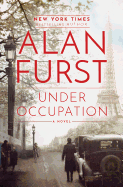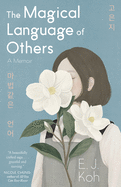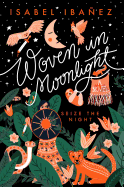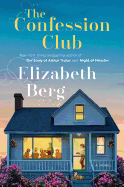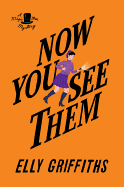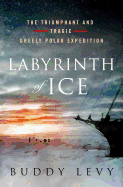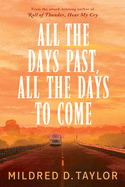Friday, January 10, 2020
Jhumpa Lahiri next to Flavia de Luce. Agatha Christie stacked atop Anne Lamott. E.B. White's essays, cheek by jowl with Anne of Green Gables. My bookshelves look totally different these days--since I moved to a new apartment this summer and agreed to let my sister color-code them.
I was skeptical. What type-A bookworm wouldn't be? I'd always arranged my books carefully by genre, then by author. I thought I wouldn't be able to find anything. But the new arrangement is both gorgeous and surprisingly accessible. Bonus: I'm rediscovering some titles when they catch my eye from their reshuffled positions.
Favorites from several years ago, like Rebecca Pacheco's Do Your Om Thing (Harper Wave, $16.99) or Andi Teran's Ana of California (Penguin, $16), wink at me constantly these days. I'm rereading the Harry Potter series again, and searching for each multicolored spine (I have the British editions) is a mini-treasure hunt. And my poetry collections (heavy on the Mary Oliver) are scattered throughout, prompting me to pull them out and read a poem or two.
It's especially fun when a friend asks about a book: let me see where that is. Oh, yes, the cover is blue, but the spine might be red. Some series, like Laurie R. King's excellent Mary Russell mysteries, are scattered all over the place. A few, like my Penguin-orange Thursday Next adventures (Penguin, $17), are happily, haphazardly stacked together (with Ann Patchett's essays [Harper Perennial, $16.99] and Life of Pi [Houghton Mifflin Harcourt, $15.95]). And on the fireplace, a tower of black-spined classics (like The Count of Monte Cristo [Penguin, $16]) shares space with newer stunners, including Kate Quinn's The Huntress (HarperCollins, $16.99).
My bookshelves are still a snapshot of my reading life, but these days, the picture is a much more colorful one. I'm savoring the rainbow it creates along my walls, and the unexpected pleasure of beloved volumes, seen in a vivid new way. --Katie Noah Gibson, blogger at Cakes, Tea and Dreams
The Confession Club
by Elizabeth Berg
When a participant in a local dining club in Mason, Mo., reveals a personal secret over dinner, the gathering is suddenly transformed into a "safe space": members of the group share not only a weekly feast, but begin to confess dilemmas from their private lives. Elizabeth Berg's illuminating novel The Confession Club brings together a small group of women--ages 20 to their 70s--who maintain an oath of confidentiality as they voice their sins, burdens, inadequacies and shameful secrets, offering each other opinions and advice without judgment. Among the members are a preacher's wife, who is a kleptomaniac; a woman remorseful over the way she chronically lied to her parents during adolescence; and another who finds herself attracted to an exhibitionist.
New additions to the group include some beloved characters from Berg's prior novels, including Iris Winters, from Night of Miracles, a divorcée who runs a baking school out of her home. She falls for a handsome, bright, high-functioning--yet homeless--Vietnam veteran with PTSD. And Maddy Harris, introduced in The Story of Arthur Truluv, is a married mother who returns to town to regroup and reconcile feelings from the past that prohibit her from sharing her soul with her husband.
Readers don't need to be familiar with Berg's prior books in the Mason series to enjoy this one--a tenderhearted, at times philosophical, patchwork quilt of stories. Berg extols the benefits of these unlikely people forming a bond and a community of trust and friendship that changes their lives for the better. --Kathleen Gerard, blogger at Reading Between the Lines
Discover: In this illuminating novel, a group of women form an unlikely bond of trust that allows them to share personal revelations.
Two Blankets, Three Sheets
by Rodaan Al Galidi, transl. by Jonathan Reeder
Another name for a passport? "That book without any poetry at all." When Iraqi Samir Karim lands in Amsterdam to request asylum, his first stop is the bathroom--to flush his documents down the toilet, at the outset of Rodaan Al Galidi's exceptional Two Blankets, Three Sheets. What follows is an updated Catch-22, replete with life-or-death stakes, absurd rules and mindless enforcement, tracing Karim's nearly decade-long limbo treading in the choppy waters of a Dutch Asylum Seekers' Center (ASC).
Having fled war-torn Iraq to avoid service in Saddam Hussein's army, Karim recalls, "During the bombardment of Baghdad, when heaven and earth had become one great hell, I once watched a father try to convince his frightened child of about five that what he saw was really just fireworks." Even as he loses fellow asylum seekers to suicide, family to illness and relationships to cultural misunderstanding, Karim manages to adopt the same approach, reframing his circumstances to mine lessons, or laughs, from the painful. (A typical quip: "Being late in an ASC is like a fart in a bubble bath.")
Born in Iraq, poet and writer Al Galidi became a Dutch citizen after a protracted, precarious wait, during which he taught himself Dutch and won the European Union Prize for Literature. His story, and the trenchant, critical Two Blankets, Three Sheets, reveals just how selectively people are permitted to traverse the world. Stories like it will hopefully help that world become more empathetic--and a lot funnier in the meantime. --Katie Weed
Discover: This funny, frank story will build awareness and empathy for asylum seekers and anyone simply trying to find a safe place to live.
Recipe for a Perfect Wife
by Karma Brown
Characters often face difficult choices--and learn how to live with the consequences--in the novels of Karma Brown (The Choices We Make). In Recipe for a Perfect Wife, she continues this theme, chronicling the lives of two women who lived nearly 60 years apart.
In 2018, 29-year-old Alice Hale and her husband, Nate, move from a "shoebox-size" apartment in the Murray Hill section of Manhattan to a sprawling colonial house in Greenville, a suburban town "less than an hour's train ride from the city and yet an entirely different world." Alice has apprehensions about the retro fixer-upper, but nevertheless makes the adjustment.
While Nate commutes to his city job, Alice, having left her career and friends behind to write a novel, feels a deep loneliness. When she finds a vintage cookbook in the basement and begins whipping up some of the recipes, her anxiety and depression start to lift. She becomes intrigued and wants to find out all she can about Nellie Murdoch, the previous owner of the cookbook and the house.
As Alice learns more about Nellie's life, she faces unexpected crises that force her to rethink choices she's made, secrets she's kept and actions she may need to take in the future. Patriarchal dilemmas abound for both women. Yet, through the wisdom evoked by revelations in Nellie's life story, Alice is suddenly inspired and empowered better to deal with her own challenges.
Strong, well-drawn women anchor Brown's deeply thought-provoking, feminist novel. The spellbinding dual stories complement each other, raising themes of self-discovery, self-preservation and liberation for two women living eras apart. --Kathleen Gerard, blogger at Reading Between the Lines
Discover: A powerful, thought-provoking story about the choices that ultimately come to define and liberate two women who lived 60 years apart.
Mystery & Thriller
Under Occupation
by Alan Furst
Armed with a propulsive and dramatic plot, Alan Furst's Under Occupation is a tight historical thriller. The 15th book in the Night Soldiers series of loosely connected spy novels opens in 1942 Nazi-occupied Paris, as a man hunted by the Gestapo hands a mysterious sketch to passerby (and French Resistance sympathizer) Paul Ricard. Once Ricard gives the drawing to the Resistance, however, he and his friend Kasia are pulled deeper and deeper into the dangerous world of the spy network.
Ultimately, Under Occupation excels in portraying a country dominated by enemy powers whose very presence is suffocating. Furst depicts the ruthlessness required to battle that enemy properly; one scene in particular viciously dramatizes this. Even the smallest characters are marked by what choices they make in the Occupation. The spies on both sides do what is necessary no matter the cost, and part of Ricard's journey involves making such unimaginable decisions. Although the Gestapo are the main "bad guys," the war itself is what hangs over all of the players and forces their hands.
Furst breaks no conventions yet crafts a crackling piece of work steeped in moral ambiguity and superb, imaginative prose. The author has succeeded in evoking a place and time that has faded into memory and breathes life into it again. No historical fiction reader can ask for more. --C.M. Crockford, freelance reviewer
Discover: Fans of Furst's Night Soldiers books won't want to miss this insightful, intelligent spy novel.
Now You See Them
by Elly Griffiths
Two decades after their adventures combining magic tricks with military operations during World War II, former colleagues Max Mephisto and Edgar Stephens have settled down to family life. Now You See Them, the fifth entry in Elly Griffiths's (The Vanishing Box) Magic Men mystery series, finds Edgar serving as the superintendent of Brighton's police force, while his wife, former detective sergeant Emma Holmes, looks after their three children and wishes she could join Edgar in his work.
Their magician friend Max is mostly enjoying his semi-retirement in California, but all three of them are drawn into a mysterious kidnapping case that reminds Max irresistibly of their old stage illusions. As the tensions between two battling youth subcultures, the mods and rockers, run high in Brighton, Edgar is preoccupied with arranging security for the upcoming bank holiday weekend while searching for three young women who have disappeared. When Max's daughter Ruby, a TV star, also goes missing, Max and the press (including Emma's journalist friend Sam) get involved.
Griffiths's plotting skills, well known from her Ruth Galloway mystery series, are on full display here, as is her talent for sharp thumbnail sketches of even minor characters. She provides enough context to satisfy readers new to the series, though returning readers will better appreciate the nuances of character and multiple references to past adventures. The seemingly unrelated kidnappings eventually coalesce into a proper case, complete with red herrings and mysterious notes. With glimpses into the colorful youth culture of the 1960s and flashes of Griffiths's dry wit, Now You See Them is an enjoyable addition to an entertaining series. --Katie Noah Gibson, blogger at Cakes, Tea and Dreams
Discover: Elly Griffiths's fifth Magic Men case investigates the disappearance of several young women in 1960s Brighton.
Graphic Books
In Search of Lost Time: In the Shadow of Young Girls in Flower
by Marcel Proust, illus. by Stéphane Heuet, transl. by Laura Marris
At first glance, the famed seven-part autobiographical novel known collectively as In Search of Lost Time is a curious candidate for an illustrated adaptation. Known as much for its length as its content, the expertise and commitment required convincingly to distill Marcel Proust's prose into the graphic novel form makes the task appear more daunting than worthwhile. Fortunately, French comics artist Stéphane Heuet has taken up the challenge in a project he began in 1998. In a preface to the initial collected volume to be published in English (Swann's Way, 2015), translator Arnold Goldhammer described Heuet's adaptation as "a piano reduction of an orchestral score."
Using a style reminiscent of Tintin cartoonist Hergé, Heuet resists the urge to embellish or alter the story with unnecessary flourishes. The result is a graphic adaptation that reads like a dream, floating across the memories that serve as the literary spine of Proust's opus with agile dexterity. Whereas Swann's Way (and its immortal madeleine moment) focuses primarily on the narrator's youth spent in Combray, In the Shadow of Young Girls in Flower instead travels to Balbec. The fictional Normandy seaside resort is the setting for the narrator to experience his adolescence, including the time he spends with Albertine--the woman he proclaims to be the greatest love of his life. A brilliant gateway into the full Proust experience, Heuet's work accomplishes the unthinkable by condensing In Search of Lost Time without ever dishonoring its author's intent. --Zack Ruskin, freelance reviewer
Discover: This illustrated adaptation of the second volume in Marcel Proust's daunting masterwork faithfully preserves the heart of the story in a refreshing format.
Biography & Memoir
The Magical Language of Others: A Memoir
by E.J. Koh
Poet and translator E.J. Koh grew up in California's Bay Area, the daughter of Korean immigrants. Her parents moved back to Korea when she was 15, leaving her to live with her angry, taciturn 19-year-old brother. By the time her parents returned to the United States, Koh was off to graduate school in New York City. During those years of separation, a flurry of letters from mother to daughter sketched a yearning over distance.
The Magical Language of Others revolves around these letters, translated from occasionally English-spattered Korean. Koh read them as they arrived, but it wasn't until much later, in their rediscovery, that she came to understand what they offered. In a small box she has kept for years, Koh finds exactly 49 letters: "In Buddhist tradition, forty-nine is the number of days a soul wanders the earth for answers before the afterlife."
This slim book is a memoir--of the years Koh spent quasi-orphaned in California; her visits to Korea; finally sharing a continent and eventually a home with her parents again in adulthood. It is also a study of generations of women before her. Koh considers how people make poetry out of imperfect lives and how they interpret and generate love. In startling, lyrical, imaginative prose, Koh wrestles with the meanings of devotion and duty and with the challenges of language and translation. Her final lines are as heartbreakingly beautiful as the entire book deserves. The Magical Language of Others is a masterpiece, a love letter to mothers and daughters everywhere. --Julia Kastner, librarian and blogger at pagesofjulia
Discover: Letters from mother to daughter shed glimmering light on reunions, reconciliation, immigration, heritage and familial love.
Health & Medicine
The Myth of the Perfect Pregnancy: A History of Miscarriage in America
by Lara Freidenfelds
In The Myth of the Perfect Pregnancy: A History of Miscarriage in America, historian Lara Freidenfelds describes how social, medical and technological forces over the past 250 years have conspired to create "a cultural consensus that fertility should be subject to individual control and planning, and that parenting should primarily be a matter of affection and attachment." This consensus, while not without its upsides, leads to heartbreak, guilt and stigma when it clashes with the biological reality of miscarriage.
It has also, Freidenfelds argues, created a new, modern experience of pregnancy loss. This "new experience," she shows, is partly temporal: discovering pregnancies very early also means experiencing miscarriages that would have been indistinguishable from normal menstrual periods in earlier eras. But prospective parents in the 21st century expect to have near-perfect control over their pregnancies and are therefore likely to view miscarriage as a tragic, personal failure. Freidenfelds traces this modern experience of miscarriage to its origins in colonial America, showing how it resulted directly from changing attitudes toward fertility and parenting, the rise of the medical management of pregnancy and--insidiously--a booming capitalist culture around pregnancy and babies.
Evidenced throughout, and made explicit in the final chapter, Freidenfelds provides not just a fascinating, well-researched history, but also uses that history to dismantle unrealistic expectations of perfection and to argue for a more humane understanding of miscarriage. Given how common miscarriage is, a broad range of readers have much to gain from Freidenfelds's call for a more compassionate and realistic approach to the subject. --Hannah Calkins, writer and editor in Indianapolis
Discover: Fascinating and expertly researched, this book traces the social, medical and technological forces that have shaped modern experiences of fertility, parenting and pregnancy loss.
Travel Literature
Labyrinth of Ice: The Triumphant and Tragic Greely Polar Expedition
by Buddy Levy
In Labyrinth of Ice, Buddy Levy (River of Darkness) has created a gripping account of historical adventure and horror that maintains tension from beginning to end, despite the conclusion having been known for more than 130 years.
In 1881, Lieutenant Adolphus Greely set out on a United States Army expedition, leading 24 men with the goal of exploring the Arctic and breaking the British record Farthest North. Working tirelessly to record scientific measurements, the crew drove off wolves and grappled with the mental health effects of cramped quarters in the continual night of the Arctic winter. When the ship meant to resupply them the following year failed to arrive, Greely followed the agreed-upon plan to begin the trek south before winter in 1883. Then they became trapped for the season by the weather and managed to find only a small emergency cache of supplies left by the ship Proteus, which had sunk on its way to resupply them. There were whispers of mutiny, the mental health of many crew members deteriorated further and starvation became a looming threat.
Levy takes a generally favorable view of Greely, focusing on his adaptation to the unbearable circumstances and his growth in leadership as he balanced seeking the advice and consent of his men with enforcing military command. Levy also highlights the devotion of Henrietta Greely, who campaigned tirelessly for the army to rescue her husband. This compelling true drama will impress readers with the human capacity for survival. --Kristen Allen-Vogel, information services librarian at Dayton Metro Library
Discover: This nail-biting recounting of an Arctic expedition that ended in disaster is perfect for fans of Nathaniel Philbrick and Erik Larson.
Poetry
I Offer My Heart as a Target / Ofrezco mi corazón como una diana
by Johanny Vázquez Paz, transl. by Lawrence Schimel
Puerto Rican poet Johanny Vázquez Paz won the Paz Prize for Poetry, given by the National Poetry Series, for her bilingual book of poetry, I Offer My Heart as a Target / Ofrezco mi corazón como una diana. Presented in both Spanish and English, and with an introduction by Rigoberto González, I Offer My Heart as a Target is an eminently relevant selection of poems for anyone tuned into the issues of the day, including identity formation and representation, immigration, the #MeToo movement, family trauma and institutionalized "-isms." This collection reflects the harsh realities of a life impacted by both personal and systemic difficulties.
Divided into two sections, the poems in "My Heart as a Target" speak to Vázquez Paz's family and relationship life experiences: "I'm not the princess you dreamed to make your queen./ Nor are you the king who came to rescue me from myself." Meanwhile, the poems in "When the Flight Takes Off" illustrate a life of mixed heritage, immigration/migration and culture in diaspora: "I am the daughter of migrations and conquests/ civilizations that have impregnated my DNA/ (some with love/ others with neither permission nor clemency)."
A Facebook ad for the Paz Prize for Poetry inspired Vázquez Paz, whose novel Sagrada familia won the International Latino Book Award in 2015, to enter the competition during a trying time in her life. The evocative language and lyrical descriptions in these poems provide thoughtful symbolism to contextualize a range of experiences accessible to everyone sharing in the trauma of the world today. --BrocheAroe Fabian, owner, River Dog Book Co., Beaver Dam, Wis.
Discover: Poet Johanny Vázquez Paz covers important and traumatic topics in a beautiful, evocative bilingual collection.
Children's & Young Adult
Woven in Moonlight
by Isabel Ibañez
Ximena is the Condesa of Illustria, a refugee nation hidden in the mountains of their home country. Her throne was usurped by the Llacsans, who won the land in a revolt after a decades-long refusal to assimilate with Ximena's people. But Ximena has a secret--she is a decoy. Her friend, Catalina, was switched with Ximena, a war orphan, to keep the true heir safe. When the new king, Atoc, demands that the Condesa marry him, Ximena and Catalina see it as an opportunity to find the Estrella, a legendary stone with vast magical powers. They know the Estrella is concealed somewhere in Atoc's castillo and, if they can find it, they will use it to take back the throne.
Ximena's rash behavior and training as a resistance fighter, however, make Atoc and his confidants suspicious. As her attempts to get word out to Catalina are thwarted, her allies killed and her actions closely watched, Ximena finds help with El Lobo, a mysterious vigilante beloved by her people. El Lobo teaches Ximena the Llacsans' version of their shared country's history and what happened to spark their revolt. As Ximena gets closer to finding the Estrella, she must decide which future she wants for her country: victory through violence or negotiated peace.
Isabel Ibañez's gorgeously written YA debut builds a world that feels true to life with a distinctive magic system at its core. The revolt and the politics between the Illustrians and Llacsans are nuanced and the characters from both groups are fully fleshed individuals with their own motives. Readers are likely to empathize with Ximena's struggles as she attempts to find her true self within her dual identities. Woven in Moonight spins a satisfying tale of adventure, romance and magic. --Clarissa Hadge, bookstore manager, Trident Booksellers & Cafe, Boston, Mass.
Discover: Ximena seeks to overthrow a false king in Isabel Ibañez's YA debut adventure.
What's Up, Maloo?
by Genevieve Godbout
On a good day, "no other kangaroo can hop like Maloo!" But in this endearing, approachable look at dealing with sadness, readers will understand that bad times happen, too. When all looks bleak, with the right kind of help, it's entirely possible to turn things around.
When the story begins, Maloo, a cheerful-looking kangaroo in bright yellow overalls, hops through a field of pink flowers: "One hop. Two hops. Three hops." But then the hopping stops: "Hop?" Maloo, no longer cheerful, takes "One step. Two steps. Three steps" to a gopher friend's house. When cake doesn't lift Maloo's spirits, the pair goes in search of another friend. But neither crocodile's water toys nor koala's many fans can chase away Maloo's gloom. "Let us help you, Maloo," gopher, crocodile and koala all say. The caring friends walk and talk and, most importantly, stick together, until they find a way to help (literally) bring back Maloo's hop.
The deceptively simple storyline in What's Up, Maloo? belies an important message about the healing power of friendship. Maloo's companions show their respect for the kangaroo's feelings and, when Maloo is ready, their caring attention pays off. Genevieve Godbout's (When Santa Was a Baby) earthy color palette and soft textures give the work a soothing air, and her expressive pastel and colored-pencil illustrations clearly describe the emotions of her characters; Maloo's posture sags and a dark fog hovers around the kangaroo's head until the final pages, when ("hop-hop-hurray!") the friends' gentle encouragement pays off and Maloo's spirits lift. A tribute to the benefits of showing up and simply being there, What's Up, Maloo? demonstrates how the very best of friends can make a sad day hoppier, one step at a time. --Lynn Becker, blogger and host of Book Talk, a monthly online discussion of children's books for SCBWI
Discover: Hopping is the perfect metaphor to illustrate a state of mind as gloomy Maloo's friends repeatedly try to lift the kangaroo's spirits in Genevieve Godbout's picture book.
All the Days Past, All the Days to Come
by Mildred D. Taylor
Newbery award winner Mildred D. Taylor (Roll of Thunder, Hear My Cry) concludes the Logan family saga in this decades-spanning epic of self-discovery set against the backdrop of the U.S. civil rights movement.
Cassie's story picks up in 1944, 27 months after the events of The Road to Memphis, and follows the Logan family into the early 1960s. Now a young adult, Cassie follows her older brother Stacey to Toledo, Ohio, during the Great Migration, anxious to make a life away from the racism and brutality of their native Mississippi. But she and her family members quickly learn that while the North may not have "Whites Only" signs, segregation and racism persist throughout the post-World War II U.S. As the years pass, Cassie finds both the greatest love and grief of her life in California, sanctuary followed by betrayal in Colorado and a purpose and profession in Boston. However, Cassie feels anchored to her home in Mississippi by the unbroken circle of the Logan family and the fight for justice and equality for black Americans.
Taylor portrays coming-of-age as a lifelong process as Cassie, smart and determined as ever, faces discrimination, sexual harassment, pressure from her family to marry a man they find acceptable and threats to her loved ones' lives. Teen readers and adults who fondly recall the Logans during their previous spellbinding adventures will appreciate the mature themes, as well as Taylor's great gift for writing about ordinary people in extraordinary times. With this monumental closing chapter, the author fittingly ends her celebrated series. --Jaclyn Fulwood, youth services manager at Main Branch, Dayton Metro Library
Discover: In the final volume of Mildred Taylor's Logan family saga, a now-grown Cassie and her brothers seek a future in the North but never forget their origins.


